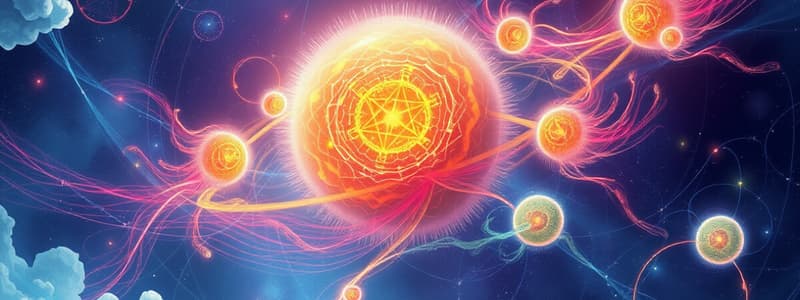Podcast
Questions and Answers
What is the primary function of the parathyroid glands?
What is the primary function of the parathyroid glands?
- Releasing adrenaline during stress
- Producing insulin
- Homeostatic control of calcium metabolism (correct)
- Controlling growth and metabolism
Which of the following hormones can cross the cell membrane and affect transcription factors directly?
Which of the following hormones can cross the cell membrane and affect transcription factors directly?
- Insulin
- Adrenaline
- Protein hormones
- Thyroid hormones (correct)
How do protein hormones typically affect transcription factors?
How do protein hormones typically affect transcription factors?
- By entering the nucleus of the cell
- By directly altering DNA
- By binding to cell membrane receptors and activating messenger molecules (correct)
- By decreasing the metabolic rate
What role do transcription factors play in gene expression?
What role do transcription factors play in gene expression?
Which gland has both exocrine and endocrine functions?
Which gland has both exocrine and endocrine functions?
What is the effect of thyroxine at cold temperatures?
What is the effect of thyroxine at cold temperatures?
What is a common feature of endocrine glands?
What is a common feature of endocrine glands?
What is the primary role of positive feedback mechanisms in biological systems?
What is the primary role of positive feedback mechanisms in biological systems?
Which scenario exemplifies a positive feedback mechanism?
Which scenario exemplifies a positive feedback mechanism?
Why is positive feedback generally not involved in homeostasis?
Why is positive feedback generally not involved in homeostasis?
During hypothermia, which of the following represents a breakdown of homeostasis that could result in a positive feedback loop?
During hypothermia, which of the following represents a breakdown of homeostasis that could result in a positive feedback loop?
What is a significant characteristic of hormones produced in endocrine glands?
What is a significant characteristic of hormones produced in endocrine glands?
Which of the following is NOT a method the body uses to reduce temperature?
Which of the following is NOT a method the body uses to reduce temperature?
What response occurs when the body's temperature rises?
What response occurs when the body's temperature rises?
What effect does vasodilation have on body temperature regulation?
What effect does vasodilation have on body temperature regulation?
Study Notes
Positive Feedback Mechanisms
- Positive feedback amplifies changes, moving the system further from normal levels.
- Effectors contribute to an increase in the response, enhancing the original stimulus.
- Useful in rapid activation processes, such as blood clotting after injury.
- May lead to adverse conditions like hypothermia when a homeostatic system fails.
Mechanisms to Reduce Body Temperature
- Sweating cools the body as water evaporates from the skin, removing heat.
- Hair position adjustment: Erector pili muscles relax, causing hairs to lie flat, reducing insulation and promoting heat loss.
- Vasodilation: Arterioles near the skin surface dilate, increasing blood flow and facilitating heat loss through radiation.
Characteristics of Positive Feedback Systems
- Less common compared to negative feedback mechanisms and not primarily involved in homeostasis.
- Example: Uterine contractions during labor, where pressure from the baby's head triggers increased contraction via chemical release.
Hormones and Their Functions
- Hormones are organic substances produced by endocrine glands and released into the bloodstream.
- Can be proteins, peptides (e.g., insulin, antidiuretic hormone), or steroids (e.g., estrogen, testosterone).
- Influence various body functions, from rapid physiological responses to long-term changes like growth during puberty.
Endocrine Glands Overview
- Located throughout the body, many glands have dual functions (e.g., ovaries produce ova and hormones).
- Glands release hormones directly into the blood (endocrine), unlike exocrine glands that use ducts.
- Key glands include:
- Pituitary and hypothalamus involved in hormone regulation.
- Thyroid glands influencing growth and metabolism.
- Parathyroid glands regulating calcium metabolism.
- Pancreas controlling blood sugar via insulin and glucagon.
- Adrenal glands producing hormones like adrenaline for stress responses.
- Kidneys producing hormones for red blood cell synthesis and vitamin D metabolism.
Regulation of Gene Transcription by Hormones
- Transcription factors are proteins that regulate gene activity by binding to DNA.
- Activators boost transcription rates, while repressors decrease them.
- Some hormones (steroids, thyroid hormones) penetrate cell membranes, altering gene transcription directly.
Hormonal Regulation of Body Temperature
- At normal temperature, thyroid hormone receptor decreases transcription of metabolic rate-increasing genes.
- At low temperatures, thyroxine release converts the receptor into an activator, increasing transcription and protein synthesis.
- Elevated protein levels boost metabolic rate, leading to increased body temperature.
Hormones Working from the Cell Membrane
- Some hormones (e.g., protein hormones) cannot cross cell membranes but still influence transcription factors.
- They bind to cell surface receptors, activating messenger molecules that trigger internal cascades.
- This process engages protein kinases, leading to the activation of transcription factors and ultimately affecting gene transcription.
Studying That Suits You
Use AI to generate personalized quizzes and flashcards to suit your learning preferences.



